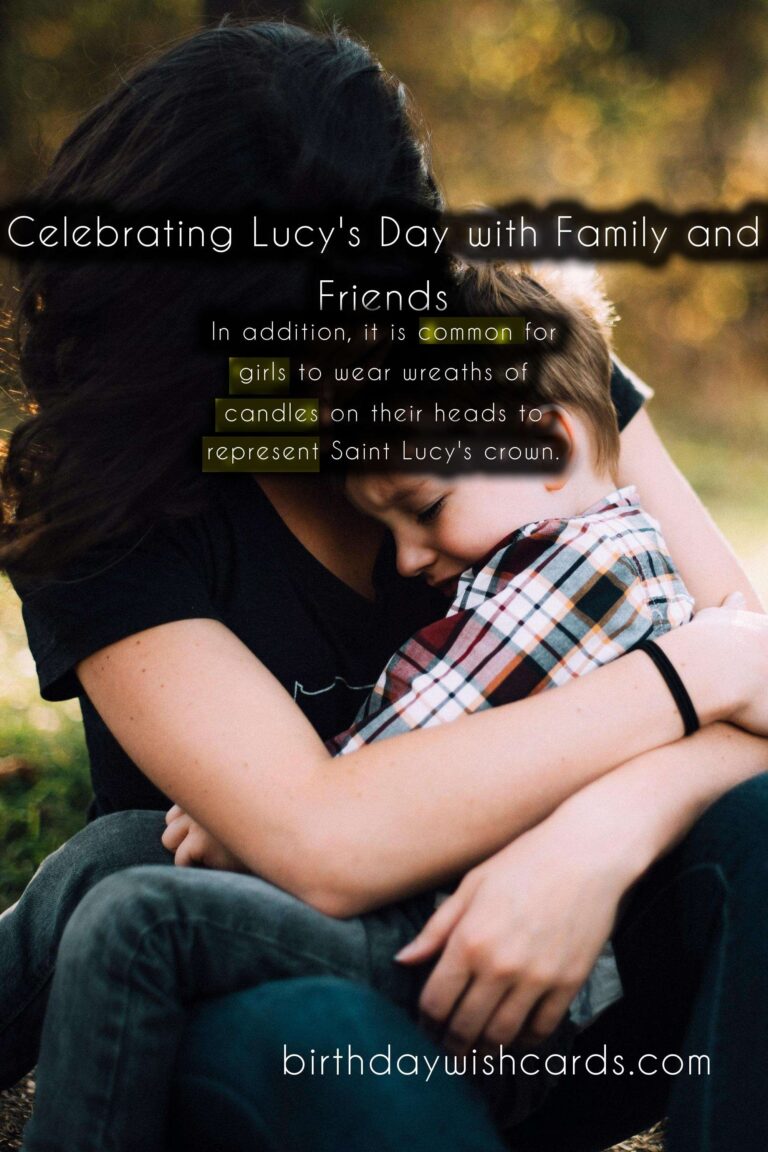 December 13 marks the celebration of Lucy’s Day, also known as St. Lucy’s Day or Luciadagen. It is a Scandinavian holiday that honors Saint Lucy, a Christian martyr who is revered for her generosity and kindness. Despite the religious origins of this holiday, Lucy’s Day is celebrated by people of all faiths, and it has become a cherished tradition in many parts of the world. This article will delve into the history and customs of Lucy’s Day, as well as the various ways in which it is celebrated. The origins of Lucy’s Day can be traced back to the 4th century, when Saint Lucy lived in Syracuse, Italy. Legend has it that Saint Lucy chose to dedicate her life to God instead of marrying a wealthy man chosen by her father. Her decision angered her suitor, who then reported her to the Roman authorities as a Christian. As a consequence, Saint Lucy was persecuted and eventually executed for her refusal to renounce her faith. Her death occurred on December 13, which is why this date is now recognized as her feast day. Many people believe that Saint Lucy’s death was a demonstration of her unwavering devotion to God and her commitment to spreading his teachings. In some countries, such as Finland, December 13 is known as the Day of Light because it signifies the return of the light after the winter solstice. It is also believed that Saint Lucy brings light and hope to those who are experiencing darkness, both literally and figuratively. In Scandinavian countries, especially Sweden, Denmark, and Norway, Lucy’s Day is celebrated with much fanfare. One of the main traditions of this holiday is the crowning of a young girl as the Lucy Bride or Lussibruden. The chosen girl wears a white dress and a red sash, and she embodies the spirit of Saint Lucy through her kindness and generosity. The Lucy Bride then leads a procession, or a Lucia train, carrying candles and wearing a crown of lingonberry branches and lit candles on her head. This symbolizes the bringing of light into the darkness, and it is a beautiful sight to behold. The Lucia train goes to schools, hospitals, and nursing homes, spreading joy and light to those who are unable to celebrate outside their homes. Another important aspect of Lucy’s Day is the traditional meal of lussekatter, a type of sweet bread flavored with saffron. This bread is eaten in the morning to start the day off with a warm and comforting treat. In some parts of Sweden, it is also customary for the family to serve coffee and hot chocolate in bed to the parents, who are woken up by the children singing songs and presenting them with lussekatter. This is a cherished moment in many households, and it brings families together in a joyous celebration. Other traditions on Lucy’s Day include wearing white clothes, lighting candles, and decorating with evergreens and mistletoe. In addition, it is common for girls to wear wreaths of candles on their heads to represent Saint Lucy’s crown. Some also say that on this special day, animals are able to speak and understand human language, so it is customary for people to treat their pets with extra kindness and affection. Lucy’s Day is also celebrated in other parts of the world, such as Italy, where it is known as Santa Lucia Day. In many Italian towns and cities, young girls dressed in white and carrying candles represent Saint Lucy in annual parades. Some regions in Italy also celebrate by serving special dishes, such as cuccia, a dessert made out of wheat grains, honey, and ricotta cheese. Lucy’s Day has also become popular in countries where Scandinavian communities have migrated, such as in the United States, Canada, and Australia. In these countries, people with Scandinavian heritage continue to honor their traditions and pass them on to future generations. In conclusion, Lucy’s Day on December 13 is a special holiday that commemorates the life and teachings of Saint Lucy. It is a celebration of light, kindness, and generosity, and it brings people together in a shared expression of joy and hope. Whether you are of Scandinavian descent or simply want to learn about different cultures, Lucy’s Day is a wonderful way to experience the beauty and spirit of this holiday. So, mark your calendars and join in on the festivities on Lucy’s Day. You won’t be disappointed!
December 13 marks the celebration of Lucy’s Day, also known as St. Lucy’s Day or Luciadagen. It is a Scandinavian holiday that honors Saint Lucy, a Christian martyr who is revered for her generosity and kindness. Despite the religious origins of this holiday, Lucy’s Day is celebrated by people of all faiths, and it has become a cherished tradition in many parts of the world. This article will delve into the history and customs of Lucy’s Day, as well as the various ways in which it is celebrated. The origins of Lucy’s Day can be traced back to the 4th century, when Saint Lucy lived in Syracuse, Italy. Legend has it that Saint Lucy chose to dedicate her life to God instead of marrying a wealthy man chosen by her father. Her decision angered her suitor, who then reported her to the Roman authorities as a Christian. As a consequence, Saint Lucy was persecuted and eventually executed for her refusal to renounce her faith. Her death occurred on December 13, which is why this date is now recognized as her feast day. Many people believe that Saint Lucy’s death was a demonstration of her unwavering devotion to God and her commitment to spreading his teachings. In some countries, such as Finland, December 13 is known as the Day of Light because it signifies the return of the light after the winter solstice. It is also believed that Saint Lucy brings light and hope to those who are experiencing darkness, both literally and figuratively. In Scandinavian countries, especially Sweden, Denmark, and Norway, Lucy’s Day is celebrated with much fanfare. One of the main traditions of this holiday is the crowning of a young girl as the Lucy Bride or Lussibruden. The chosen girl wears a white dress and a red sash, and she embodies the spirit of Saint Lucy through her kindness and generosity. The Lucy Bride then leads a procession, or a Lucia train, carrying candles and wearing a crown of lingonberry branches and lit candles on her head. This symbolizes the bringing of light into the darkness, and it is a beautiful sight to behold. The Lucia train goes to schools, hospitals, and nursing homes, spreading joy and light to those who are unable to celebrate outside their homes. Another important aspect of Lucy’s Day is the traditional meal of lussekatter, a type of sweet bread flavored with saffron. This bread is eaten in the morning to start the day off with a warm and comforting treat. In some parts of Sweden, it is also customary for the family to serve coffee and hot chocolate in bed to the parents, who are woken up by the children singing songs and presenting them with lussekatter. This is a cherished moment in many households, and it brings families together in a joyous celebration. Other traditions on Lucy’s Day include wearing white clothes, lighting candles, and decorating with evergreens and mistletoe. In addition, it is common for girls to wear wreaths of candles on their heads to represent Saint Lucy’s crown. Some also say that on this special day, animals are able to speak and understand human language, so it is customary for people to treat their pets with extra kindness and affection. Lucy’s Day is also celebrated in other parts of the world, such as Italy, where it is known as Santa Lucia Day. In many Italian towns and cities, young girls dressed in white and carrying candles represent Saint Lucy in annual parades. Some regions in Italy also celebrate by serving special dishes, such as cuccia, a dessert made out of wheat grains, honey, and ricotta cheese. Lucy’s Day has also become popular in countries where Scandinavian communities have migrated, such as in the United States, Canada, and Australia. In these countries, people with Scandinavian heritage continue to honor their traditions and pass them on to future generations. In conclusion, Lucy’s Day on December 13 is a special holiday that commemorates the life and teachings of Saint Lucy. It is a celebration of light, kindness, and generosity, and it brings people together in a shared expression of joy and hope. Whether you are of Scandinavian descent or simply want to learn about different cultures, Lucy’s Day is a wonderful way to experience the beauty and spirit of this holiday. So, mark your calendars and join in on the festivities on Lucy’s Day. You won’t be disappointed! 












